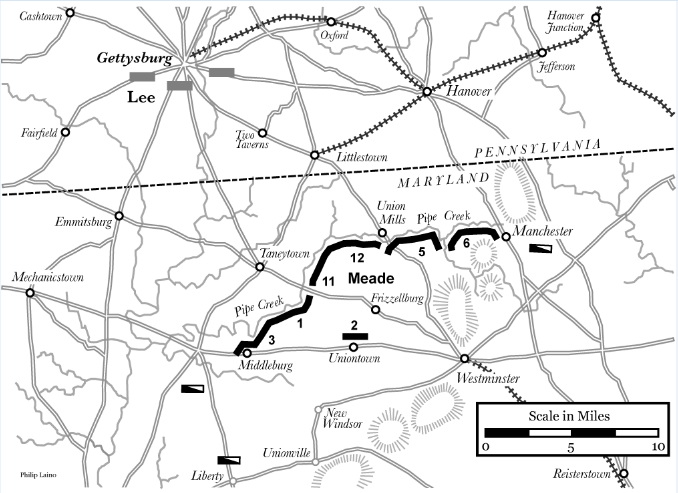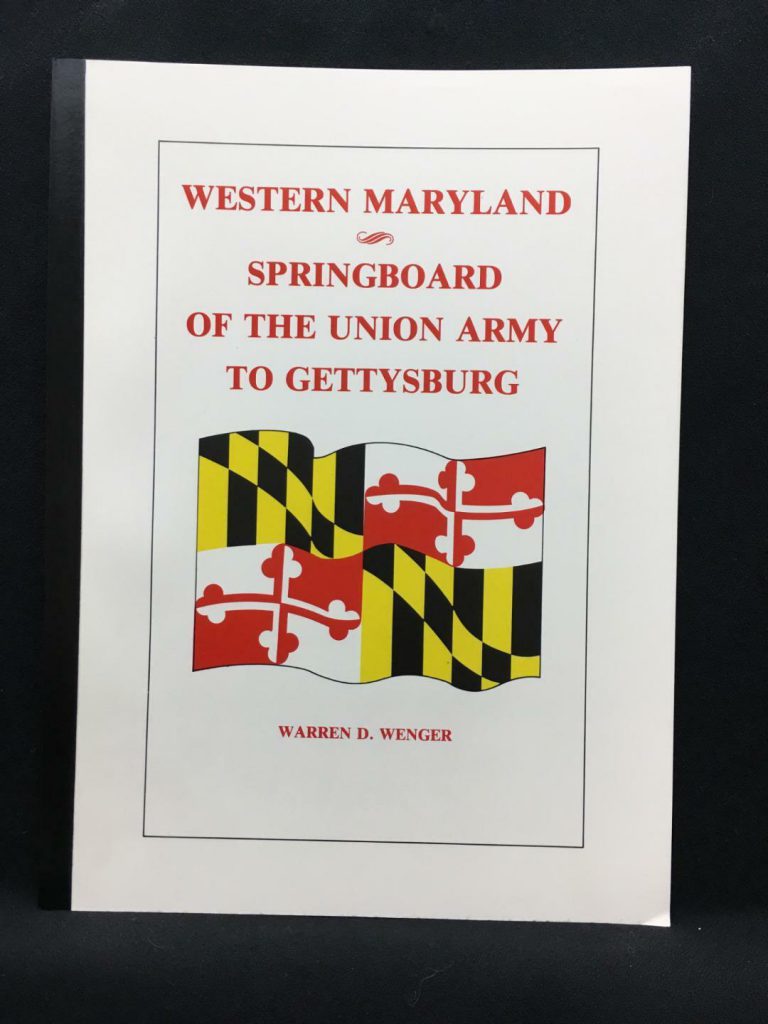Add title

When the story of Gettysburg is taught in school almost no one is told about the nearby Pipe Creek. In point of fact, it could have (should have) been the Battle of Pipe’s Creek that those lessons would recount. But because of an unlikely series of events and decisions, Pipe Creek is not usually on the radar screen of history.
In all likelihood it could have developed into an even more epic battle than the one that actually took place at Gettysburg. We will reserve a description of what ‘could have been’ until the ALT Hx section of this website. [see Section 27]
Suffice it to say that Westminster and not Gettysburg should have been the crossroads town that was being fought over. And if Lee had listened to Longstreet, that is the battle that history would have most likely recorded as the turning point of the war.
If Lee had prevailed at Pipe Creek, all of his objectives would have been achieved and the North American continent would have seen the birth of a new nation: the full-fledged Confederate States of America!
==========================================
As the Union forces were moving to counter Lee’s invasion of the north, the city of Westminster took on a primary importance. It was vital that the Union protect it. Hooker sent his Chief Engineer and Artillery Commander to locate a way to defend it. Just a few miles north they came upon a series of hills overlooking a deep streambed, Pipe Creek. They mapped out a defensive line that ran in an arc of about 18 miles. It was anchored on the right at the town of Manchester and on the left at Middleburg. These hills were not contiguous but BG Hunt the Artillery Commander thought that he could provide more than adequate protection by placing his artillery batteries to cover those low areas while the infantry protected the hills. Plus the channel cut by the stream over millennia would act as a moat in front of the line. Another major advantage is that these positions blocked the mains roads to the south: The Baltimore Pike and the road to Taneytown. Both of these routes crossed the creek on stone bridges which could easily be defended.
On 30 June Meade published the PIPE CREEK CIRCULAR:
This was written late on the night of June 30 and based on the reports of his engineers, directed that, if and when the circular was made effective the Army would form a line of battle along the general line of the creek with the left at Middleburg and the right at Manchester. This position would cover the main routes to Baltimore and Washington, and the important railroads running to the same cities, with the added advantage that Parr’s Ridge-Dug Hill Ridge would furnish an excellent reserve line to fall back on in case of need.
CIRCULAR
HEADQUARTERS ARMY OF THE POTOMAC,
Taneytown, July 1, 1863.
From information received, the commanding general is satisfied that the object of the movement of the army in this direction has been accomplished, viz, the relief of Harrisburg, and the prevention of the enemy’s intended invasion of Philadelphia, &c., beyond the Susquehanna. It is no longer his intention to assume the offensive until the enemy’s movements or position should render such an operation certain of success.
If the enemy assume the offensive, and attack, it is his intention, after holding them in check sufficiently long, to withdraw the trains and other impedimenta; to Withdraw the army from its present position, and form line of battle with the left resting in the neighborhood of Middleburg, and the right at Manchester, the general direction being that of Pipe Creek. For this purpose, General Reynolds, in command of the left, will withdraw the force at present at Gettysburg, two corps by the road to Taneytown and Westminster, and, after crossing Pipe Creek, deploy toward Middleburg. The corps at Emmitsburg will be withdrawn, via Mechanicsville, to Middleburg, or, if a more direct route can be found leaving Taneytown to their left, to withdraw direct to Middleburg.
General Slocum will assume command of the two corps at Hanover and Two Taverns, and withdraw them, via Union Mills, deploying one to the right and one to the left, after crossing Pipe Creek, connecting on the left with General Reynolds, and communicating his right to General Sedgwick at Manchester, who will connect with him and form the right.
The time for falling back can only be developed by circumstances. Whenever such circumstances arise as would seem to indicate the necessity for falling back and assuming this general line indicated, notice of such movement will be at once communicated to these headquarters and to all adjoining corps commanders.
The Second Corps now at Taneytown will be held in reserve in the vicinity of Uniontown and Frizellburg, to be thrown to the point of strongest attack, should the enemy make it. In the event of these movements being necessary, the trains and impedimenta will all be sent to the rear of Westminster.
Corps commanders, with their officers commanding artillery and the divisions, should make themselves thoroughly familiar with the country indicated, all the roads and positions, so that no possible confusion can ensue, and that the movement, if made, be done with good order, precision, and care, without loss or any detriment to the morale of the troops.
The commanders of corps are requested to communicate at once the nature of their present positions, and their ability to hold them in case of any sudden attack at any point by the enemy.
This order is communicated, that a general plan, perfectly understood by all, may be had for receiving attack, if made in strong force, upon any portion of our present position.
Developments may cause the commanding general to assume the offensive from his present positions.
The Artillery Reserve will, in the event of the general movement indicated, move to the rear of Frizellburg, and be placed in position, or sent to corps, as circumstances may require, under the general supervision of the chief of artillery.
The chief quartermaster will, in case of the general movement indicated, give directions for the orderly and proper position of the trains in rear of Westminster.
All the trains will keep well to the right of the road in moving, and, in case of any accident requiring a halt, the team must be hauled out of the line, and not delay the movements.
The trains ordered to Union Bridge in these events will be sent to Westminster.
General headquarters will be, in case of this movement, at Frizellburg; General Slocum as near Union Mills as the line will render best for him; General Reynolds at or near the road from Taneytown to l.
The chief of artillery will examine the line, and select positions for artillery.
The cavalry will be held on the right and left flanks after the movement is completed. Previous to its completion, it will, as now directed, cover the front and exterior lines, well out.
The commands must be prepared for a movement, and, in the event of the enemy attacking us on the ground indicated herein, to follow up any repulse.
The chief signal officer will examine the line thoroughly, and at once, upon the commencement of this movement, extend telegraphic communication from each of the following points to general headquarters near Frizellburg, viz, Manchester, Union Mills, Middleburg, and the Taneytown road.
All true Union people should be advised to harass and annoy the enemy in every way, to send in information, and taught how to do it; giving regiments by number of colors, number of guns, generals’ names, &c. All their supplies brought to us will be paid for, and not fall into the enemy’s hands.
Roads and ways to move to the right or left of the general line should be studied and thoroughly understood. All movements of troops should be concealed, and our dispositions kept from the enemy. Their knowledge of these dispositions would be fatal to our success, and the greatest care must be taken to prevent such an occurrence.
By command of Major-General Meade:
S. WILLIAMS,
Assistant Adjutant-General.
MEMORANDA
HEADQUARTERS ARMY OF THE POTOMAC,
July 1, 1863.
So much of the instructions contained in the circular of this date, just sent to you, as relates to the withdrawal of the corps at Emmitsburg should read as follows:
The corps at Emmitsburg should be withdrawn, via Mechanics-town, to Middleburg, or, if a more direct route can be found leaving Taneytown to the left, to withdraw direct to Middleburg.
Please correct the circular accordingly.
By command of Major-General Meade:
S. WILLIAMS,
Assistant Adjutant-General.
Since assuming command of the Army from Hooker, Meade was concerned about his Chain of Command. Hence the Circular reduced that somewhat by delegating authority to LTG Reynolds on the left flank and Slocum on the right.
A more complete discussion of the Pipe Creek plan can be found at:
https://civilwarhome.com/pcl.html

Also recommended:


A more professional look at THE PLAN:
